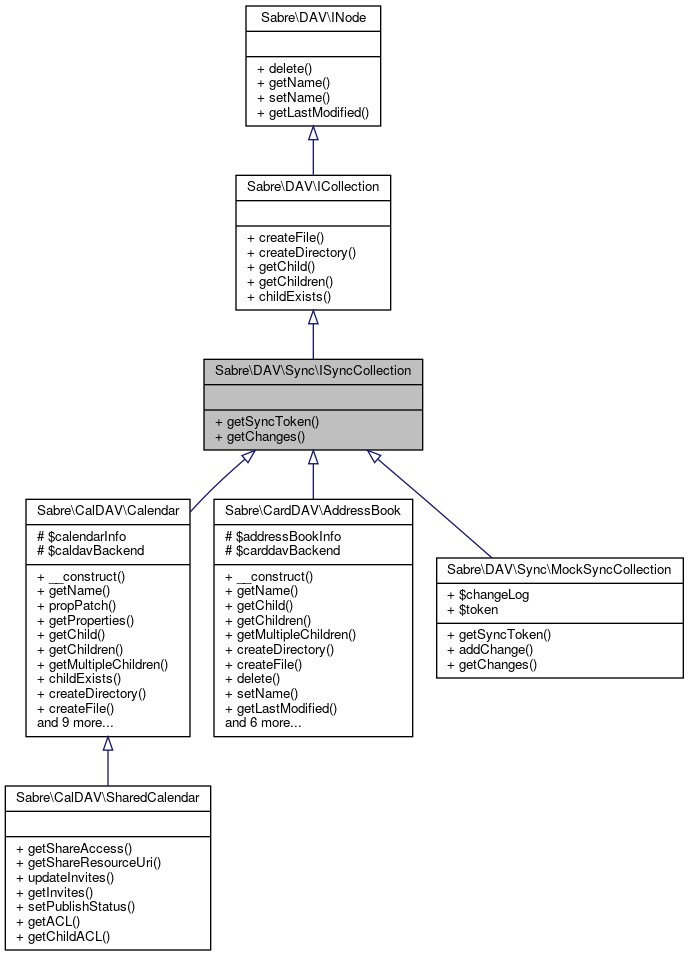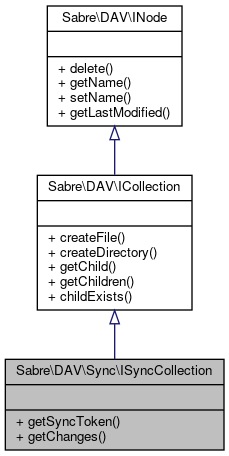If a class extends ISyncCollection, it supports WebDAV-sync. More...
 Inheritance diagram for Sabre\DAV\Sync\ISyncCollection:
Inheritance diagram for Sabre\DAV\Sync\ISyncCollection: Collaboration diagram for Sabre\DAV\Sync\ISyncCollection:
Collaboration diagram for Sabre\DAV\Sync\ISyncCollection:Public Member Functions | |
| getSyncToken () | |
| This method returns the current sync-token for this collection. More... | |
| getChanges ($syncToken, $syncLevel, $limit=null) | |
| The getChanges method returns all the changes that have happened, since the specified syncToken and the current collection. More... | |
 Public Member Functions inherited from Sabre\DAV\ICollection Public Member Functions inherited from Sabre\DAV\ICollection | |
| createFile ($name, $data=null) | |
| Creates a new file in the directory. More... | |
| createDirectory ($name) | |
| Creates a new subdirectory. More... | |
| getChild ($name) | |
| Returns a specific child node, referenced by its name. More... | |
| getChildren () | |
| Returns an array with all the child nodes. More... | |
| childExists ($name) | |
| Checks if a child-node with the specified name exists. More... | |
 Public Member Functions inherited from Sabre\DAV\INode Public Member Functions inherited from Sabre\DAV\INode | |
| delete () | |
| Deleted the current node. More... | |
| getName () | |
| Returns the name of the node. More... | |
| setName ($name) | |
| Renames the node. More... | |
| getLastModified () | |
| Returns the last modification time, as a unix timestamp. More... | |
Detailed Description
If a class extends ISyncCollection, it supports WebDAV-sync.
You are responsible for maintaining a changelist for this collection. This means that if any child nodes in this collection was created, modified or deleted in any way, you should maintain an updated changelist.
- Copyright
- Copyright (C) fruux GmbH (https://fruux.com/)
Definition at line 18 of file ISyncCollection.php.
Member Function Documentation
◆ getChanges()
| Sabre\DAV\Sync\ISyncCollection::getChanges | ( | $syncToken, | |
| $syncLevel, | |||
$limit = null |
|||
| ) |
The getChanges method returns all the changes that have happened, since the specified syncToken and the current collection.
This function should return an array, such as the following:
[ 'syncToken' => 'The current synctoken', 'added' => [ 'new.txt', ], 'modified' => [ 'modified.txt', ], 'deleted' => array( 'foo.php.bak', 'old.txt' ) ];
The syncToken property should reflect the current syncToken of the collection, as reported getSyncToken(). This is needed here too, to ensure the operation is atomic.
If the syncToken is specified as null, this is an initial sync, and all members should be reported.
The modified property is an array of nodenames that have changed since the last token.
The deleted property is an array with nodenames, that have been deleted from collection.
The second argument is basically the 'depth' of the report. If it's 1, you only have to report changes that happened only directly in immediate descendants. If it's 2, it should also include changes from the nodes below the child collections. (grandchildren)
The third (optional) argument allows a client to specify how many results should be returned at most. If the limit is not specified, it should be treated as infinite.
If the limit (infinite or not) is higher than you're willing to return, you should throw a Sabre\DAV\Exception\TooMuchMatches() exception.
If the syncToken is expired (due to data cleanup) or unknown, you must return null.
The limit is 'suggestive'. You are free to ignore it.
- Parameters
-
string $syncToken int $syncLevel int $limit
- Returns
- array
Implemented in Sabre\CalDAV\Calendar, Sabre\CardDAV\AddressBook, and Sabre\DAV\Sync\MockSyncCollection.
◆ getSyncToken()
| Sabre\DAV\Sync\ISyncCollection::getSyncToken | ( | ) |
This method returns the current sync-token for this collection.
This can be any string.
If null is returned from this function, the plugin assumes there's no sync information available.
- Returns
- string|null
Implemented in Sabre\CalDAV\Calendar, Sabre\CardDAV\AddressBook, and Sabre\DAV\Sync\MockSyncCollection.
Referenced by Sabre\DAV\Sync\Plugin\getSupportedReportSet(), and Sabre\DAV\Sync\Plugin\validateTokens().
 Here is the caller graph for this function:
Here is the caller graph for this function:The documentation for this interface was generated from the following file:
- libs/composer/vendor/sabre/dav/lib/DAV/Sync/ISyncCollection.php



